Yanyu Li
Improving the Diffusability of Autoencoders
Feb 20, 2025Abstract:Latent diffusion models have emerged as the leading approach for generating high-quality images and videos, utilizing compressed latent representations to reduce the computational burden of the diffusion process. While recent advancements have primarily focused on scaling diffusion backbones and improving autoencoder reconstruction quality, the interaction between these components has received comparatively less attention. In this work, we perform a spectral analysis of modern autoencoders and identify inordinate high-frequency components in their latent spaces, which are especially pronounced in the autoencoders with a large bottleneck channel size. We hypothesize that this high-frequency component interferes with the coarse-to-fine nature of the diffusion synthesis process and hinders the generation quality. To mitigate the issue, we propose scale equivariance: a simple regularization strategy that aligns latent and RGB spaces across frequencies by enforcing scale equivariance in the decoder. It requires minimal code changes and only up to 20K autoencoder fine-tuning steps, yet significantly improves generation quality, reducing FID by 19% for image generation on ImageNet-1K 256x256 and FVD by at least 44% for video generation on Kinetics-700 17x256x256.
LazyDiT: Lazy Learning for the Acceleration of Diffusion Transformers
Dec 17, 2024Abstract:Diffusion Transformers have emerged as the preeminent models for a wide array of generative tasks, demonstrating superior performance and efficacy across various applications. The promising results come at the cost of slow inference, as each denoising step requires running the whole transformer model with a large amount of parameters. In this paper, we show that performing the full computation of the model at each diffusion step is unnecessary, as some computations can be skipped by lazily reusing the results of previous steps. Furthermore, we show that the lower bound of similarity between outputs at consecutive steps is notably high, and this similarity can be linearly approximated using the inputs. To verify our demonstrations, we propose the \textbf{LazyDiT}, a lazy learning framework that efficiently leverages cached results from earlier steps to skip redundant computations. Specifically, we incorporate lazy learning layers into the model, effectively trained to maximize laziness, enabling dynamic skipping of redundant computations. Experimental results show that LazyDiT outperforms the DDIM sampler across multiple diffusion transformer models at various resolutions. Furthermore, we implement our method on mobile devices, achieving better performance than DDIM with similar latency.
SnapGen-V: Generating a Five-Second Video within Five Seconds on a Mobile Device
Dec 13, 2024Abstract:We have witnessed the unprecedented success of diffusion-based video generation over the past year. Recently proposed models from the community have wielded the power to generate cinematic and high-resolution videos with smooth motions from arbitrary input prompts. However, as a supertask of image generation, video generation models require more computation and are thus hosted mostly on cloud servers, limiting broader adoption among content creators. In this work, we propose a comprehensive acceleration framework to bring the power of the large-scale video diffusion model to the hands of edge users. From the network architecture scope, we initialize from a compact image backbone and search out the design and arrangement of temporal layers to maximize hardware efficiency. In addition, we propose a dedicated adversarial fine-tuning algorithm for our efficient model and reduce the denoising steps to 4. Our model, with only 0.6B parameters, can generate a 5-second video on an iPhone 16 PM within 5 seconds. Compared to server-side models that take minutes on powerful GPUs to generate a single video, we accelerate the generation by magnitudes while delivering on-par quality.
SnapGen: Taming High-Resolution Text-to-Image Models for Mobile Devices with Efficient Architectures and Training
Dec 12, 2024Abstract:Existing text-to-image (T2I) diffusion models face several limitations, including large model sizes, slow runtime, and low-quality generation on mobile devices. This paper aims to address all of these challenges by developing an extremely small and fast T2I model that generates high-resolution and high-quality images on mobile platforms. We propose several techniques to achieve this goal. First, we systematically examine the design choices of the network architecture to reduce model parameters and latency, while ensuring high-quality generation. Second, to further improve generation quality, we employ cross-architecture knowledge distillation from a much larger model, using a multi-level approach to guide the training of our model from scratch. Third, we enable a few-step generation by integrating adversarial guidance with knowledge distillation. For the first time, our model SnapGen, demonstrates the generation of 1024x1024 px images on a mobile device around 1.4 seconds. On ImageNet-1K, our model, with only 372M parameters, achieves an FID of 2.06 for 256x256 px generation. On T2I benchmarks (i.e., GenEval and DPG-Bench), our model with merely 379M parameters, surpasses large-scale models with billions of parameters at a significantly smaller size (e.g., 7x smaller than SDXL, 14x smaller than IF-XL).
Efficient Training with Denoised Neural Weights
Jul 16, 2024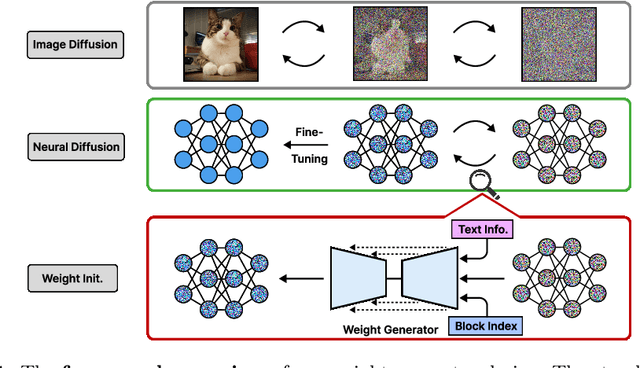
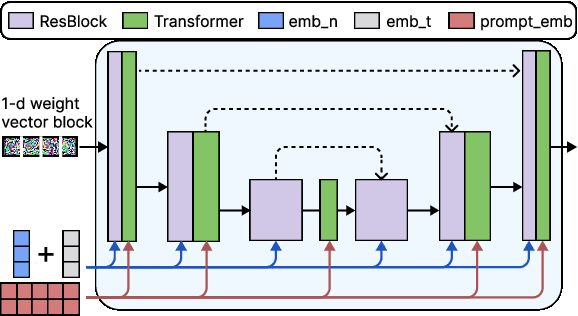
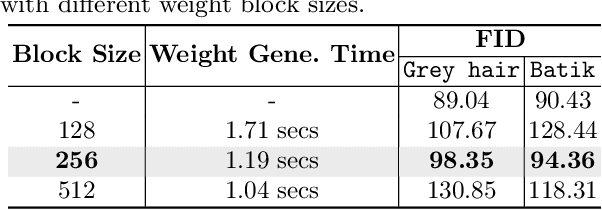
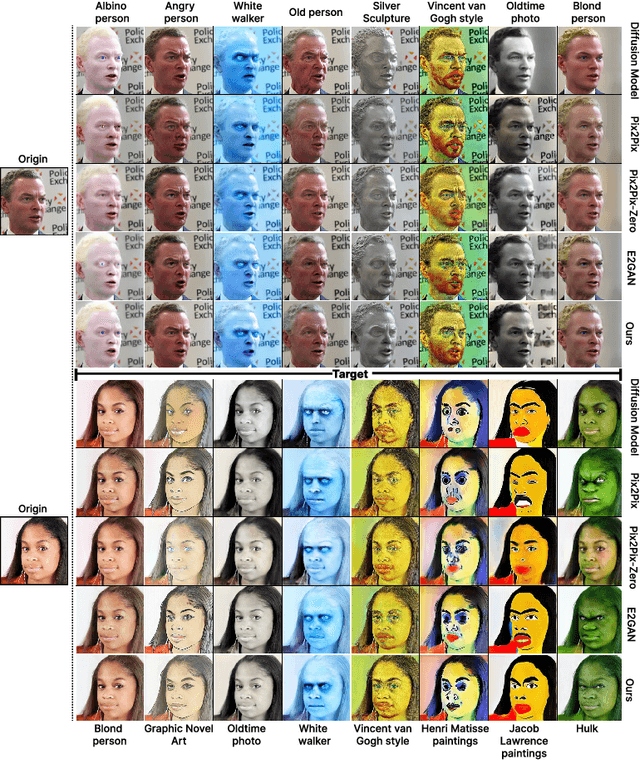
Abstract:Good weight initialization serves as an effective measure to reduce the training cost of a deep neural network (DNN) model. The choice of how to initialize parameters is challenging and may require manual tuning, which can be time-consuming and prone to human error. To overcome such limitations, this work takes a novel step towards building a weight generator to synthesize the neural weights for initialization. We use the image-to-image translation task with generative adversarial networks (GANs) as an example due to the ease of collecting model weights spanning a wide range. Specifically, we first collect a dataset with various image editing concepts and their corresponding trained weights, which are later used for the training of the weight generator. To address the different characteristics among layers and the substantial number of weights to be predicted, we divide the weights into equal-sized blocks and assign each block an index. Subsequently, a diffusion model is trained with such a dataset using both text conditions of the concept and the block indexes. By initializing the image translation model with the denoised weights predicted by our diffusion model, the training requires only 43.3 seconds. Compared to training from scratch (i.e., Pix2pix), we achieve a 15x training time acceleration for a new concept while obtaining even better image generation quality.
SF-V: Single Forward Video Generation Model
Jun 06, 2024Abstract:Diffusion-based video generation models have demonstrated remarkable success in obtaining high-fidelity videos through the iterative denoising process. However, these models require multiple denoising steps during sampling, resulting in high computational costs. In this work, we propose a novel approach to obtain single-step video generation models by leveraging adversarial training to fine-tune pre-trained video diffusion models. We show that, through the adversarial training, the multi-steps video diffusion model, i.e., Stable Video Diffusion (SVD), can be trained to perform single forward pass to synthesize high-quality videos, capturing both temporal and spatial dependencies in the video data. Extensive experiments demonstrate that our method achieves competitive generation quality of synthesized videos with significantly reduced computational overhead for the denoising process (i.e., around $23\times$ speedup compared with SVD and $6\times$ speedup compared with existing works, with even better generation quality), paving the way for real-time video synthesis and editing. More visualization results are made publicly available at https://snap-research.github.io/SF-V.
BitsFusion: 1.99 bits Weight Quantization of Diffusion Model
Jun 06, 2024

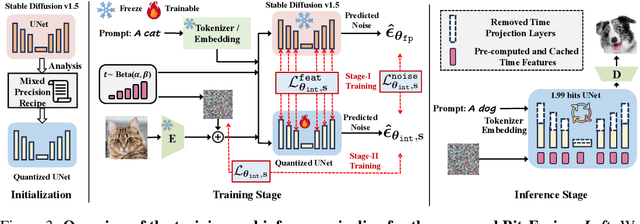

Abstract:Diffusion-based image generation models have achieved great success in recent years by showing the capability of synthesizing high-quality content. However, these models contain a huge number of parameters, resulting in a significantly large model size. Saving and transferring them is a major bottleneck for various applications, especially those running on resource-constrained devices. In this work, we develop a novel weight quantization method that quantizes the UNet from Stable Diffusion v1.5 to 1.99 bits, achieving a model with 7.9X smaller size while exhibiting even better generation quality than the original one. Our approach includes several novel techniques, such as assigning optimal bits to each layer, initializing the quantized model for better performance, and improving the training strategy to dramatically reduce quantization error. Furthermore, we extensively evaluate our quantized model across various benchmark datasets and through human evaluation to demonstrate its superior generation quality.
TextCraftor: Your Text Encoder Can be Image Quality Controller
Mar 27, 2024



Abstract:Diffusion-based text-to-image generative models, e.g., Stable Diffusion, have revolutionized the field of content generation, enabling significant advancements in areas like image editing and video synthesis. Despite their formidable capabilities, these models are not without their limitations. It is still challenging to synthesize an image that aligns well with the input text, and multiple runs with carefully crafted prompts are required to achieve satisfactory results. To mitigate these limitations, numerous studies have endeavored to fine-tune the pre-trained diffusion models, i.e., UNet, utilizing various technologies. Yet, amidst these efforts, a pivotal question of text-to-image diffusion model training has remained largely unexplored: Is it possible and feasible to fine-tune the text encoder to improve the performance of text-to-image diffusion models? Our findings reveal that, instead of replacing the CLIP text encoder used in Stable Diffusion with other large language models, we can enhance it through our proposed fine-tuning approach, TextCraftor, leading to substantial improvements in quantitative benchmarks and human assessments. Interestingly, our technique also empowers controllable image generation through the interpolation of different text encoders fine-tuned with various rewards. We also demonstrate that TextCraftor is orthogonal to UNet finetuning, and can be combined to further improve generative quality.
E$^{2}$GAN: Efficient Training of Efficient GANs for Image-to-Image Translation
Jan 11, 2024



Abstract:One highly promising direction for enabling flexible real-time on-device image editing is utilizing data distillation by leveraging large-scale text-to-image diffusion models, such as Stable Diffusion, to generate paired datasets used for training generative adversarial networks (GANs). This approach notably alleviates the stringent requirements typically imposed by high-end commercial GPUs for performing image editing with diffusion models. However, unlike text-to-image diffusion models, each distilled GAN is specialized for a specific image editing task, necessitating costly training efforts to obtain models for various concepts. In this work, we introduce and address a novel research direction: can the process of distilling GANs from diffusion models be made significantly more efficient? To achieve this goal, we propose a series of innovative techniques. First, we construct a base GAN model with generalized features, adaptable to different concepts through fine-tuning, eliminating the need for training from scratch. Second, we identify crucial layers within the base GAN model and employ Low-Rank Adaptation (LoRA) with a simple yet effective rank search process, rather than fine-tuning the entire base model. Third, we investigate the minimal amount of data necessary for fine-tuning, further reducing the overall training time. Extensive experiments show that we can efficiently empower GANs with the ability to perform real-time high-quality image editing on mobile devices with remarkable reduced training cost and storage for each concept.
HyperHuman: Hyper-Realistic Human Generation with Latent Structural Diffusion
Oct 12, 2023Abstract:Despite significant advances in large-scale text-to-image models, achieving hyper-realistic human image generation remains a desirable yet unsolved task. Existing models like Stable Diffusion and DALL-E 2 tend to generate human images with incoherent parts or unnatural poses. To tackle these challenges, our key insight is that human image is inherently structural over multiple granularities, from the coarse-level body skeleton to fine-grained spatial geometry. Therefore, capturing such correlations between the explicit appearance and latent structure in one model is essential to generate coherent and natural human images. To this end, we propose a unified framework, HyperHuman, that generates in-the-wild human images of high realism and diverse layouts. Specifically, 1) we first build a large-scale human-centric dataset, named HumanVerse, which consists of 340M images with comprehensive annotations like human pose, depth, and surface normal. 2) Next, we propose a Latent Structural Diffusion Model that simultaneously denoises the depth and surface normal along with the synthesized RGB image. Our model enforces the joint learning of image appearance, spatial relationship, and geometry in a unified network, where each branch in the model complements to each other with both structural awareness and textural richness. 3) Finally, to further boost the visual quality, we propose a Structure-Guided Refiner to compose the predicted conditions for more detailed generation of higher resolution. Extensive experiments demonstrate that our framework yields the state-of-the-art performance, generating hyper-realistic human images under diverse scenarios. Project Page: https://snap-research.github.io/HyperHuman/
 Add to Chrome
Add to Chrome Add to Firefox
Add to Firefox Add to Edge
Add to Edge